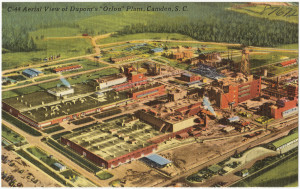As previously discussed, I work in the oil industry particularly focusing on the area surrounding DuPont and DuPont’s flame-retardant material, Nomex. But just a few months back in  December, DuPont merged with Dow Chemical Company, another of the oldest chemical companies in the United States. Together they have created a company with a market capitalization of over $130 billion combined, and with their forces joined, DowDuPont has created some of the most ubiquitous and life-changing inventions you may not even be aware of. Here is a list of some of the most notable inventions to have come out of Dow and DuPont to celebrate the merger.
December, DuPont merged with Dow Chemical Company, another of the oldest chemical companies in the United States. Together they have created a company with a market capitalization of over $130 billion combined, and with their forces joined, DowDuPont has created some of the most ubiquitous and life-changing inventions you may not even be aware of. Here is a list of some of the most notable inventions to have come out of Dow and DuPont to celebrate the merger.
Dow Chemical created and trademarked Styrofoam over sixty years ago! Although the name has been taken over as a generic term (Like Kleenex being used to refer to any tissue, regardless of brand) most of Dow’s styrofoam is used as insulation. The rest is primarily crafts-based. Lots of set building for film and stage, the foam you use to make craft wreaths, et cetera. Food-based packaging is not made from Styrofoam. While Styrofoam has gotten a bad reputation for it’s lack of environmental benefits, researchers at Stanford have been working with researchers in China to discover that mealworms can eat and digest it, and so far the excretions of the mealworms have, in testing, been found as safe to use on crops as fertilizer.
Nylon was developed at DuPont in the 1930’s by chemist Wallace Carothers. It was developed as a synthetic replacement for the silk stockings that were rapidly becoming unavailable, as silk was needed for the war effort in making parachutes for soldiers and was the best material for powder bags for naval guns. Since then, nylon can be found in everything from guitar strings to toothbrushes to emergency room sutures.
Teflon was developed after a chemist at DuPont named Roy Plunkette discovered a resin called polytetrafluoroethylene, which was actually part of a search for a new coolant, which Teflon wasn’t good for. Many at DuPont believed that slippery Teflon would be useless. Of course, it’s not a common household good on most non-stick pots and pans, but as a hydrophobic surface (neither water nor water-containing substances wet polytetrafluoroethylene) it is also used as an additive in water-resistant goods like carpets and paint.
Napalm is obviously a more controversial invention, but it came out of Dow in 1942. It is inflammable liquid used in warfare. It is a mixture of a gelling agent and petroleum or a similar fuel. It was initially used as an incendiary device against buildings and later primarily as an anti-personnel weapon, as it sticks to skin and causes severe burns when on fire.
Dow has also created artificial turf, which is made up of many layers including short absorbers, polyurethane backing, infill granules, and the upper layer of yarn that replicates the look of grass. Amongst many other uses, expect to see Dow turf at the Rio 2016 Olympic Games!
Kevlar, a fiber created by Stephanie Kwolek at DuPont, is a synthetic fiber of high tensile strength which can be used as a reinforcing agent. You can find it in tires, and other rubber products that need added strength, and obviously is most well known in protective armour such as helmets and vests like those worn by law enforcement.
Neoprene is a synthetic rubber that exhibits good chemical stability and maintains flexibility over a wide range of temperatures. It also comes from those brainiacs at DuPont. It can be sold as solid rubber or in latex for, and can be found in everything from laptop cases to diver’s wetsuits to electrical insulation.
